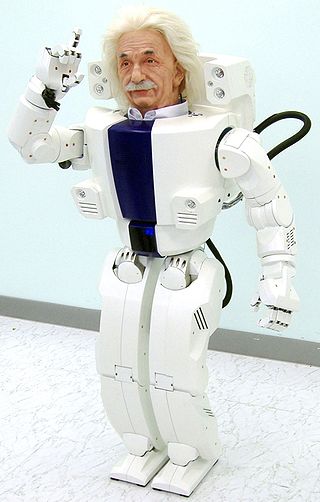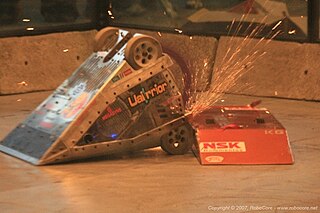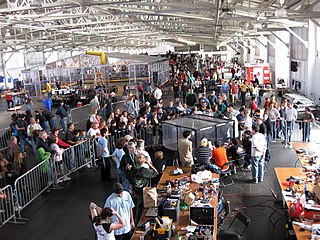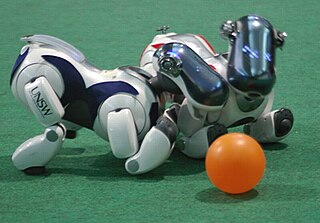Robo-One is a robot competition category of bipedal humanoid robots. The first ROBO-ONE contest was held in Japan on February 2, 2002, and consisted of an initial judged autonomous "Demonstration" stage, followed by one-on-one matches. In Japan, ROBO-ONE has spawned a whole series of related competitions including ROBO-ONE J, ROBO-ONE Special, ROBO-ONE Grand Prix, and the ROBO-ONE Technical Conference events. ROBO-ONE type contests have been held in several other countries including South Korea (official) and the United States (unofficial held by Robogames).
The robots are usually built with RC Servos as actuators and mounted together with sheet metal shapes. The most common frame material is aluminum. However, there have been entries constructed with steel, plastic, and even wood. Different sensors are used by the robot for balance and to perceive its surroundings. A small onboard micro controller or equivalent is used to control the robots movements and if the robot is autonomous it is also programmed to adjust the robots behavior in response to sensor inputs.
There have been fifteen competitions in Japan. ROBO-ONE 13 was held on March 22 and 23, at Korakuen Hall" in Takamatsu. [1] ROBO-ONE 14 occurred on October 11–12, 2008. ROBO-ONE 14 took place in at the Pacifico Yokohama Exhibition Hall. ROBO-ONE 15 was held in Kawasaki on May 4, 2009. ROBO-ONE 16 was held in Toyama City, Toyama Prefecture, on September 26–27, 2009. The 17th ROBO-ONE tournament took place in Kawasaki on March 21, 2010. A ROBO-ONE Festival was held May 22 at the Kawasaki City Industrial Promotion Hall. The festival included both ROBO-ONE Soccer and ROBO-ONE Light events. [2] The 18th ROBO-ONE event was held in Shibata, Niigata Prefecture on August 28–29, 2010. [3] The ROBO-ONE 19 competitions scheduled for March 19/20 in Kawasaki were canceled due to the 2011 Tōhoku earthquake and tsunami, and were held October 8–9, 2011. [4] The 30th ROBO-ONE took place on Sunday, February 26, 2017. The 36th ROBO-ONE took place on Sunday, February 9, 2020, at Miraikan Hall, Tokyo. [5]
Early ROBO-ONE specifications were deliberately minimal to encourage as much participation as possible. As the robots' performance has improved, the specifications have been tightened to keep the focus on 'humanoid robotics'. For example, the foot/sole size in relation to the robots overall size has been incrementally decreased for recent competitions.
With ROBO-ONE 11 (March 2007), the concept of weight classifications was introduced.
Competition rules vary based on the specific event, and have evolved over time as the robots ability has improved. The ROBO-ONE committee publishes the official rules in Japanese for each competition roughly two months in advance.
ROBO-ONE type competitions in other countries typically follow the same general format and rules, but with modifications appropriate for the participants skill and ability levels.
Competition level ROBO-ONE entries are typically custom designs, but have often been based in part on commercially available kits.

Robot-sumo, or pepe-sumo, is a sport in which two robots attempt to push each other out of a circle. The robots used in this competition are called sumobots.

RoboCup is an annual international robotics competition founded in 1996 by a group of university professors. The aim of the competition is to promote robotics and AI research by offering a publicly appealing – but formidable – challenge.
The KHR-1 is a programmable, bipedal humanoid robot introduced in June 2004 by a Japanese company Kondo Kagaku. At the time of its introduction it was one of the least expensive programmable bipedal robots. The robot is 34 cm high and has 17 degrees of freedom. It is capable of a wide range of motions, including quick kung-fu-style fighting moves.

HUBO is a walking humanoid robot, head mounted on a life-size walking bipedal frame, developed by the Korea Advanced Institute of Science and Technology (KAIST) and released on January 6, 2005. According to Hubo's creator Prof Jun-Ho Oh and his Plenary Session at ICRA 2012 entitled Development Outline of the Humanoid Robot: HUBO II the name Hubo is simply a name, not an abbreviation.

Robot combat is a type of robot competition in which custom-built machines fight using various methods to incapacitate each other. The machines have generally been remote-controlled vehicles rather than autonomous robots.
RoboCup Junior (RCJ), sometimes stylised RobocupJunior, is a division of RoboCup, a not-for-profit robotics organisation. It focuses on education and aims to introduce the larger goals of the RoboCup project to primary and secondary school aged children. Participants compete in one of three main leagues: Soccer, Rescue or Dance. Dance Theatre also exists as a sub-league of Dance, and Premier Rescue is part of the competition in Australia and New Zealand.

A robot competition is an event where the abilities and characteristics of robots may be tested and assessed. Usually they have to beat other robots in order to become the best one. Many competitions are for schools but several competitions with professional and hobbyist participants are also arising.
The Federation of International Robot-soccer Association [sic] (FIRA) is an international organisation organising competitive soccer – usually 5-a-side – competitions between autonomous robots.

As one of the founding leagues of the international RoboCup initiative, the RoboCup Middle Size League (MSL) robot soccer competition has been organised from 1997 onwards. On an indoor soccer field, with goals of reduced size, teams of five fully autonomous soccer playing robots compete against one another. No human intervention is allowed during a match, except to take robots on or from the field. Although limitations with respect to maximum size and weight are in place, teams are completely free to design both hardware and software.
Robotics is the branch of technology that deals with the design, construction, operation, structural disposition, manufacture and application of robots. Robotics is related to the sciences of electronics, engineering, mechanics, and software. The word "robot" was introduced to the public by Czech writer Karel Čapek in his play R.U.R., published in 1920. The term "robotics" was coined by Isaac Asimov in his 1941 science fiction short-story "Liar!"

RoboGames is an annual robot contest held in San Mateo, California. The last RoboGames was held April 6-9, 2023 in Pleasanton, California, having been on hiatus since the previous event in April 2018.

A soccer robot is a specialized autonomous robot and mobile robot that is used to play variants of soccer.
There are a number of competitions and prizes to promote research in artificial intelligence.
Iranian teams have been active participants of RoboCup events since 1998. The number of Iranian teams has been largely increasing over the past years. Thereby, the need to have a regional event seemed rather necessary. Furthermore, since the overall number world interested teams in RoboCup has increased; regional events may and can be a proper field for RoboCup leagues Technical Committees to see teams qualities for RoboCup World Competitions. IranOpen is a place for teams willing to take part in RoboCup World Competitions in order to show their qualities and standards. It is also a place for fresh teams to gain experience and become ready to join the world teams.
Tomotaka Takahashi is a Japanese roboticist and founder of Kyoto University's ROBO-GARAGE since 2018. Takahashi creates humanoid robots known for their smooth, fluid motions and sleek appearance. Having built many humanoid robots entirely by himself, from simple concepts to production, Takahashi's designs have been featured in several art exhibitions celebrating the creation of Astroboy, Time Magazine's Coolest Inventions of 2004, and promotions for Bandai, Panasonic, and Pepsi. He has also worked with toy companies to produce relatively inexpensive robots for the hobby market, including those for Kyosho.
Almost Human: Making Robots Think is a book written by Lee Gutkind founder of Creative Nonfiction. Gutkind spent six years as a "fly on the wall" researcher at the Robotics Institute at Carnegie-Mellon University in Pittsburgh. He observed scientists and students working to design, build, and test robots so advanced that they will one day be able to work alongside or, in some cases, even replace humans. Almost Human is an intense portrait of the robotic subculture and the challenging quest for robot autonomy. Almost Human is 330 pages long and is published by W.W. Norton. In May 2007 Gutkind appeared as a guest author on The Daily Show with Jon Stewart to talk about robots, the future, and his book.

The RoboCup Standard Platform League (SPL) is one of several leagues within RoboCup, an international competition with autonomous robotic soccer matches as the main event.

The RoboCup 3D Simulated Soccer League allows software agents to control humanoid robots to compete against one another in a realistic simulation of the rules and physics of a game of soccer. The platform strives to reproduce the software programming challenges faced when building real physical robots for this purpose. In doing so, it helps research towards the RoboCup Federation's goal of developing a team of fully autonomous humanoid robots that can win against the human world soccer champion team in 2050.

NimbRo is the robot competition team of the Autonomous Intelligent Systems group of University of Bonn, Germany. It was founded in 2004 at the University of Freiburg, Germany.

RoboMaster is an annual intercollegiate robot competition held in Shenzhen, Guangdong, China, founded and hosted by the drone tech giant DJI. First started in 2015, it is the brainchild of DJI's founder and CEO Frank Wang, and jointly sponsored by the Communist Youth League Central Committee, the All-China Students' Federation (ACSF) and the Shenzhen City Government. It is the first shooting sport-style robotics competition in China.